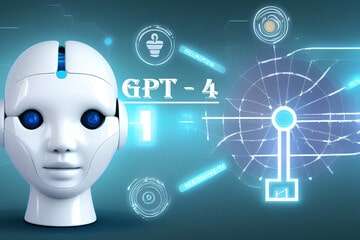
How OpenAI’s New GPT-4 is different from GPT-3?
OpenAI, the company behind ChatGPT, has released GPT-4, its newest AI language model. Generative Pre-trained Transformer is the abbreviation. This is the fourth iteration of OpenAI’s software, according to reports.
Introduction
Large language models are trained using a Generative Pre-Trained Transformer (GPT), a sophisticated neural network architecture. (LLMs). To simulate human communication, it makes extensive use of publicly accessible Internet text.
Artificial intelligence programs that handle challenging communication tasks can be developed using a GPT language model. Computers are now capable of carrying out tasks like text summarization, machine translation, classification, and code generation thanks to GPT-based LLMs. The development of conversational AI is also made possible by GPT. These AI systems can respond to queries and offer insightful commentary on the data that the models have been exposed to.
GPT is an all-text model. Artificial intelligence can navigate and analyze text more efficiently and without interruptions, if it focuses solely on text generation. Although GPT-3 is a text-only model, it is still unclear whether GPT-4 will also be a text-only model or a multi-modal neural network.
What Has Changed in GPT-4?
OpenAI’s GPT-4 language model can produce text that sounds like human speech and is a new language model. It develops the technology that ChatGPT currently employs, which is based on GPT-3.5. A deep learning tool that uses artificial neural networks to write like a human is known as GPT or Generative Pre-Trained Transformer.
- In three crucial areas, creativity, visual input, and longer context, this next-generation language model is more advanced, claims OpenAI. According to OpenAI, GPT-4 is significantly more adept at both innovating and working with users on creative projects when compared to other creativity algorithms. Examples of these include technical writing, music, screenplays, and even “learning a user’s writing style.”
- This is also influenced by the more extensive context. Up to 25,000 words of user-supplied text can now be processed by GPT-4. You could even just send GPT-4 a web address and instruct it to interact with the text on that page. According to OpenAI, this can be useful for “extended conversations” and the creation of long-form content.

As a basis for interaction, GPT-4 can now also receive images. The GPT-4 website gives an example where a chatbot is shown a picture of a few baking ingredients and is then asked what can be made with them. Whether or not video can be utilized in a similar manner is not currently known.
- OpenAI claims that in order to make these advancements, it has been trained with human feedback and has consulted with “over 50 experts for early feedback in domains including AI safety and security.”
We’re beginning to understand what it’s capable of as the first users have flocked to get their hands on it. Using a combination of HTML and JavaScript, one user used GPT-4 to quickly produce a playable version of Pong.
What are the differences between GPT-3 and GPT-4?
- GPT-4 promises a significant performance improvement over GPT-3, including an enhancement in the creation of text that more closely resembles human behavior and speed patterns.
- GPT-4 is more flexible and adaptable when it comes to handling tasks like text summarization, language translation, and other similar ones. Software that has been trained through it will be better able to predict users’ intentions, even when human error obstructs instructions.

Conclusion
Finally, GPT-3 and GPT-4 are significant developments in the area of language models. The widespread use of GPT-3 in numerous applications is evidence of the high level of interest in the technology and the continued promise of its future. Although GPT-4 has not yet been released, it is anticipated to gain significant improvements that will increase the adaptability of these strong language models. Given that these models have the potential to fundamentally alter how we interact with robots and interpret natural language, it will be fascinating to watch how they develop in the future.







